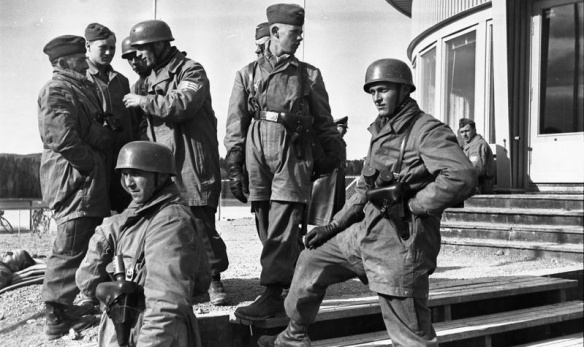Hitler decided on 3 March 1940 to conduct operations against Norway prior to the start of the Campaign in the West. To that end, he directed the use of a parachute battalion. Student recommended against that, but his objections were overruled. In order not to tear apart Sturmabteilung Koch, which was still training for its original mission, Student placed the I./FJR 1 at the disposal of the High Command. Hauptmann Walther’s battalion received the following missions:
- Half of the battalion was to be employed to occupy and secure the Oslo-Fornebu airport for subsequent landings. The half-battalion was to remain under the command of Walther.
- The 3./FJR 1, under the command of Oberleutnant von Brandis, was to take the Stavanger-Sola airport.
- The 4./FJR 1 of Hauptmann Gericke was to take the most important bridges and airports of Denmark.
When the Ju 52’s carrying Hauptmann Walther’s half battalion of men neared the Norwegian coast, there was such a “pea soup” of a fog that visibility was reduced to barely 20 meters. The pilot commanding Walther’s machine reported the minimal visibility, and Walther ordered him to go lower. But no matter how low they went, the fog seemed to extend all the way to the ocean surface.
Seconds after the order to continue flying at the lowest level possible, a loud crash shook the men in the fourth machine. Two Ju 52’s that had been following closely behind had crashed into one another and dropped to the sea below.
“Climb!” Oberstleutnant Drewes, the group commander of the II./ Kampfgeschwader z. b. V. 14, ordered as visibility dropped to zero over the islands that made up Oslo.
“What’s going on?” Hauptmann Walther asked.
“A safe drop of the two companies is impossible, Walther. We have to head for Aalborg.”
“If we don’t take the airfield, the transports following us can’t land with their forces,” he retorted.
But, in the end, the major had to bend to the insight of the transport commander. The entire formation turned and flew to Aalborg, where it landed.
The group that was following was also ordered back. But Hauptmann Wagner, the flight leader of the second group, thought the radio transmission was an enemy trick and continued the flight on to Oslo-Fornebu by himself.
The eight Me 110’s of the I./Zerstörergeschwader 76 5 of Hauptmann Ingenhoven had also arrived in the meantime. The aircraft had been detailed to support the airborne forces. Once over the air space of the airport, they started preparations to land, convinced that the paratroopers had already jumped and had the airfield under their control.
Once they started receiving defensive fires, they knew otherwise. But the aircraft had to land there. They didn’t have enough fuel to return to their home base.
Ingenhoven: “Attack and engage the enemy defenses with machine-gun fire.” The twin-engined aircraft dove and aimed their weapons in the direction of the muzzle flashes they could see. Two English “Gladiator” fighters were set ablaze before they could take off to intercept the German destroyers.
While that was happening, the aircraft with Hauptmann Wagner arrived on scene. The Ju 52 also started to turn to land and suddenly received heavy machine-gun fire. A machine-gun salvo went through the aircraft. Hauptmann Wagner, who was at the stick, was shot in the head and killed. The assistant pilot caught the machine in time, although rounds continued their deadly arc through the aircraft and hit men cried out in surprise and pain. Although the aircraft swung wildly from side to side, it climbed up out of the deathtrap over the airfield as the Me 110’s made another run.
The stricken Ju 52 also managed to reach Aalborg, where the rest of the second group had already arrived. The eight Me 110’s remained behind. They had a choice: Take the airfield or go down at sea somewhere.
Once again, the Me 110’s returned fire on the enemy and then attempted to land. The first aircraft touched down but ran out of runway. When it came to a stop, it was slightly damaged. But the rest landed without incident. Once on the ground, they all turned so that the rear of the aircraft faced the airport facilities. That way, the rear gunners had an opportunity to return fire. But the fires had ceased. The enemy had given up and abandoned his positions.
Hauptmann Ingenhoven reported: “Fornebu airfield in our hands! Airfield free for follow-on landings by paratroopers!” The airborne forces turned around, occupied the airfield and held it until Infanterie-Regiment 324, which had been designated to relieve the airborne forces, arrived. When the sixth company finished landing around noon on 9 April, they moved out on Oslo. The mission of the main group had been accomplished.
